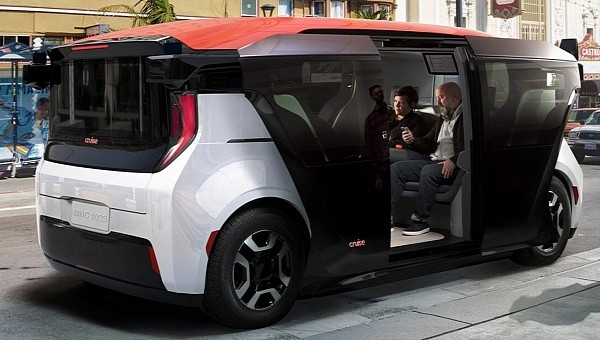Electric vehicles (EVs) can achieve the highest level of efficiency when they are shared. Replacing all the internal combustion engine (ICE) cars in the world with EVs isn’t going to do much for the time spent in bumper-to-bumper traffic. Cruise’s Origin might be one of the much-needed solutions to pollution and queues, especially as it can now be tested on California’s public roads.
GM believes autonomous vehicles (AVs) will play a major role in the upcoming years, and it's doing everything it can to stay ahead of the curve. Around two years ago, the automotive behemoth gave Cruise $5 billion to kickstart its manufacturing efforts. Last year, it strengthened its control over the company by injecting another $2.1 billion into a deal that hiked the ownership stake to 80%. Since then, Cruise has expanded its service to daytime hours in San Francisco and has announced bold plans to enter other cities.
And GM might have been right. Today, Cruise announced that its Level 4 (and Level 5-capable) LiDAR-equipped autonomous vehicle – the Origin – has received approval to start testing on California’s public roads without someone present inside the unit from the state’s Department of Motor Vehicles.
If you’ve followed this space, then you might know that Cruise uses many all-electric Chevrolet Bolt units for its driverless rides. However, the Origin has been built from the ground up to be the best autonomous vehicle possible for ridesharing. The driver was never considered, so the entire vehicle is built to accommodate up to four passengers for trips in various urban environments. Moreover, it does not have a steering wheel or a sun visor.
However, public road testing has been done in the past couple of years with a human inside the vehicle that was always ready to take over if something went wrong. From now on, there will be no need for in-car human supervision. The robotaxi will be all by itself.
The bureaucratic challenges don’t stop here for Cruise’s Origin. The self-driving shuttle still needs the National Highway Traffic Safety Administration’s (NHTSA) approval, and the company applied for a review of the vehicle a year ago. The NHTSA responded in December with an investigation into reports of hard braking and random stops causing traffic jams. We'll see how that goes.
Moreover, the Origin will have to apply for California DMV’s deployment permit and another similar document from the state’s Public Utilities Commission. So, there are a couple of things that need to be done before a wide rollout can take place.
But Cruise is not alone in this endeavor. At the time of writing, six other companies have driverless public testing permits from California’s DMV. Among these entities, we find Waymo, WeRide, and Zoox. The battle for autonomous driving supremacy is intensifying, and those working with Uber, Lyft, or cab companies might want to pay attention.
Finally, we were recently told that the best way to disconnect from work is... Commuting. So, instead of stressing about driving, insurance, gas or electricity costs, and parking, why not ride in a driverless vehicle?
And GM might have been right. Today, Cruise announced that its Level 4 (and Level 5-capable) LiDAR-equipped autonomous vehicle – the Origin – has received approval to start testing on California’s public roads without someone present inside the unit from the state’s Department of Motor Vehicles.
If you’ve followed this space, then you might know that Cruise uses many all-electric Chevrolet Bolt units for its driverless rides. However, the Origin has been built from the ground up to be the best autonomous vehicle possible for ridesharing. The driver was never considered, so the entire vehicle is built to accommodate up to four passengers for trips in various urban environments. Moreover, it does not have a steering wheel or a sun visor.
However, public road testing has been done in the past couple of years with a human inside the vehicle that was always ready to take over if something went wrong. From now on, there will be no need for in-car human supervision. The robotaxi will be all by itself.
The bureaucratic challenges don’t stop here for Cruise’s Origin. The self-driving shuttle still needs the National Highway Traffic Safety Administration’s (NHTSA) approval, and the company applied for a review of the vehicle a year ago. The NHTSA responded in December with an investigation into reports of hard braking and random stops causing traffic jams. We'll see how that goes.
Moreover, the Origin will have to apply for California DMV’s deployment permit and another similar document from the state’s Public Utilities Commission. So, there are a couple of things that need to be done before a wide rollout can take place.
But Cruise is not alone in this endeavor. At the time of writing, six other companies have driverless public testing permits from California’s DMV. Among these entities, we find Waymo, WeRide, and Zoox. The battle for autonomous driving supremacy is intensifying, and those working with Uber, Lyft, or cab companies might want to pay attention.
Finally, we were recently told that the best way to disconnect from work is... Commuting. So, instead of stressing about driving, insurance, gas or electricity costs, and parking, why not ride in a driverless vehicle?
Today we received approval from the CA DMV to test the Origin on public roads! Huge step for @Cruise as we continue to work with regulators to deploy this phenomenal, American-made vehicle. pic.twitter.com/N54a4C3eee
— Kyle Vogt (@kvogt) February 3, 2023






